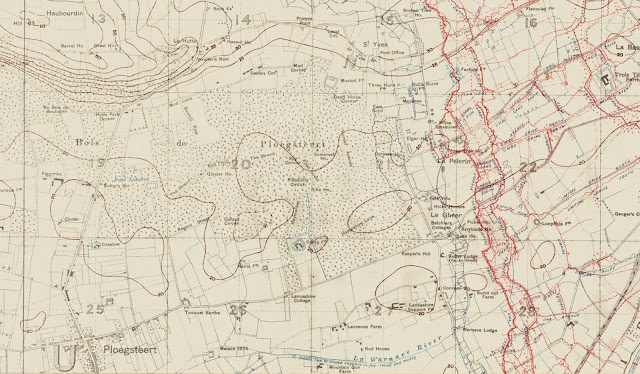At 9am the Battalion was relieved by 11th West
Yorkshires and withdrawn a few hundred yards to close reserve trenches in
Ploegsteert Wood. The relieving troops were first guided in to their new
positions, with Tunstill’s Man Sgt. Norman
Roberts (see 3rd December
1915) responsible for the safe arrival of the new Lewis gun teams, before
the men moved off, proceeding by half companies, with 100 yards between, to
their new positions. ‘A’ Company were now to be positioned at St. Andrew’s
Drive (this seems to have been close to
Mud Corner); ‘B’ at Hunter’s Avenue (Dead Horse Corner); ‘C’ “just beyond
Gloster House”; and a’D’ at Gloster House. It was noted in the War Diary that,
“there was some aeroplane activity during the afternoon”.
Pte. James Young
McDonald (see 17th July)
was wounded, suffering shrapnel wounds to his left foot; he would be evacuated
to hospital in Boulogne.
In their new positions the Battalion was joined by the six
new officers who were to replace the casualties of the previous month. Lt. Payne (see 1st September) and 2Lts. Graham, Halstead, Hunt, Isaacs and Roberts had all arrived in France a week earlier (see 25th August).
In a letter home to his wife, Brig. Genl. T.S. Lambert, commanding 69th Brigade,
reported, “It is nearly midnight now so this letter should really be dated the
3rd. We are off again so I may not have much time for writing and
certainly none for leave, but we shall have a short time for training I hope.
In the meanwhile things still seem to be going very well everywhere and I don’t
think the Boche can be happy, though we shall have to do a good deal more yet
before it is over. It will never do to let the war end before we have made
Germany suffer the personal discomforts of invasion and have let the French,
Belgians, Serbians and others get a bit of their own back, not in territory
only”.
(I am greatly indebted
to Juliet Lambert for her generosity in allowing me to reproduce the letters
here).
 |
Brig. Genl. T.S. Lambert
Image by kind permission of Juliet Lambert
|
Spr. Alfred John
Davis (see 1st July), serving
with 176th Tunnelling Company, Royal Engineers, was admitted to 14th
General Hospital at Wimereux, suffering from pleurisy. He would be evacuated to
England ten days later and admitted to hospital in England (details unknown).
L.Cpl. Matthew Best (see 10th July), who was in hospital in Newcastle-upon-Tyne having been wounded in July, underwent an operation to try to relieve the paralysis in his left arm; the outcome is unclear.
Pte. Norman Greenwood (17998) (see 13th July), who had
been in England since being wounded on the Somme in July, was now sufficiently
recovered to be posted to 3DWR at North Shields.
L.Cpl. Matthew Best (see 10th July), who was in hospital in Newcastle-upon-Tyne having been wounded in July, underwent an operation to try to relieve the paralysis in his left arm; the outcome is unclear.
 |
| L.Cpl. Matthew Best |
Pte. Edward Smitham, the eldest son of Sgt. George Edward Smitham (see 30th July), who had
attested for service (though underage), was transferred from 6th
Battalion, Seaforth Highlanders to 2nd (Garrison) Battalion West
Yorks.
Trooper Claude Darwin
(see 29th August),
serving with 11th Australian Light Horse in Egypt, who had been
taken ill a few days previously was relaeased from 24th Stationary
Hospital and discharged to duty. He was the brother of Tunstill recruit, Pte. Tom Darwin (see 24th August).
Pte. Cecil Stanley Pitblado (see 13th July), who had been wounded in March, was discharged from the Military Convalescent Hospital in Alnwick; he would have ten days’ furlough before reporting to 83rd Training Reserve Battalion, based at Gateshead.

No comments:
Post a Comment